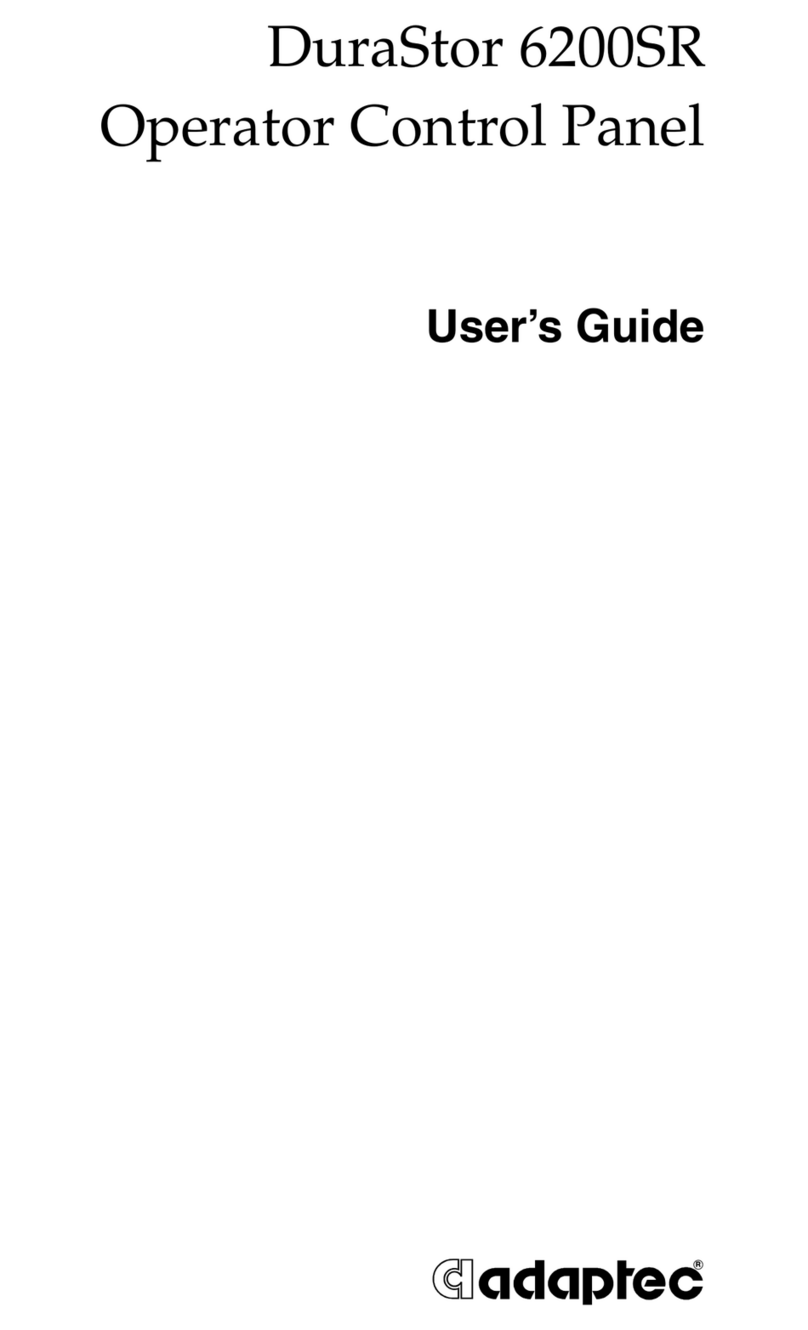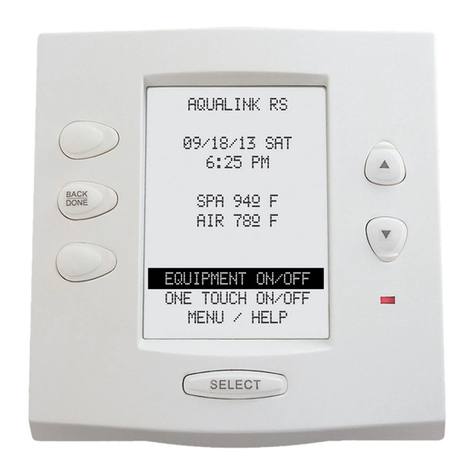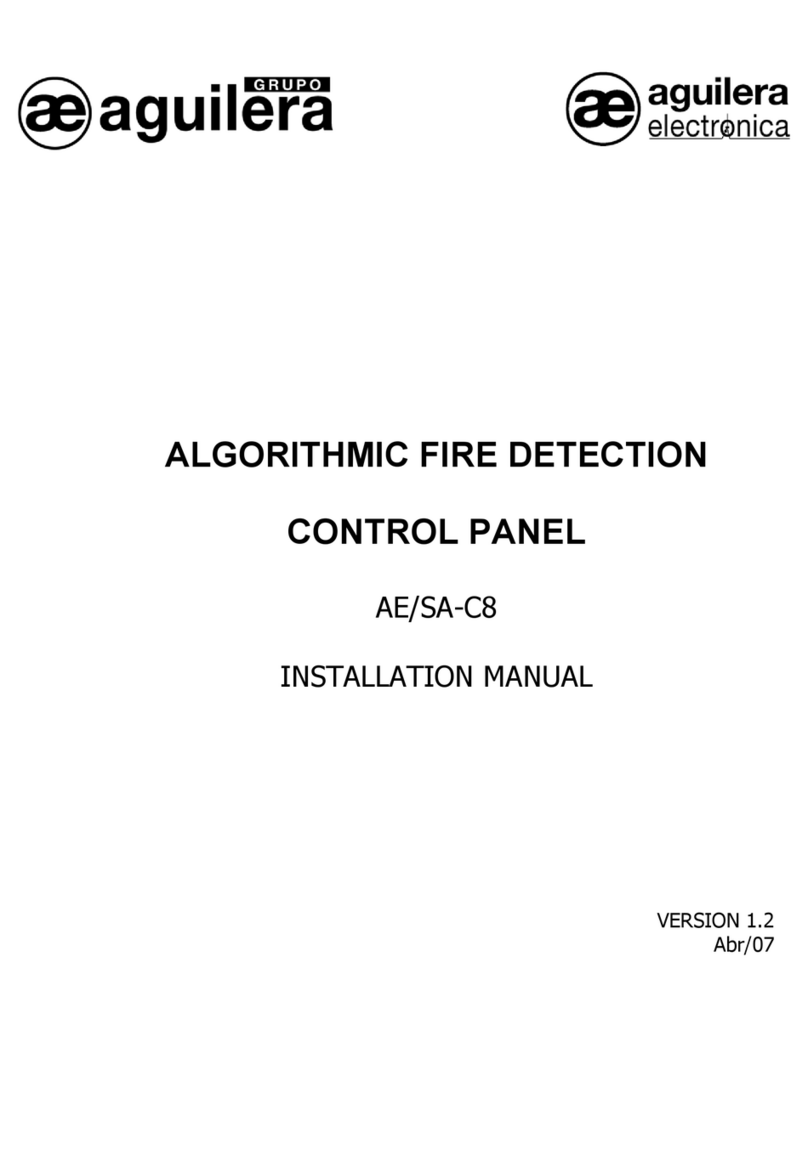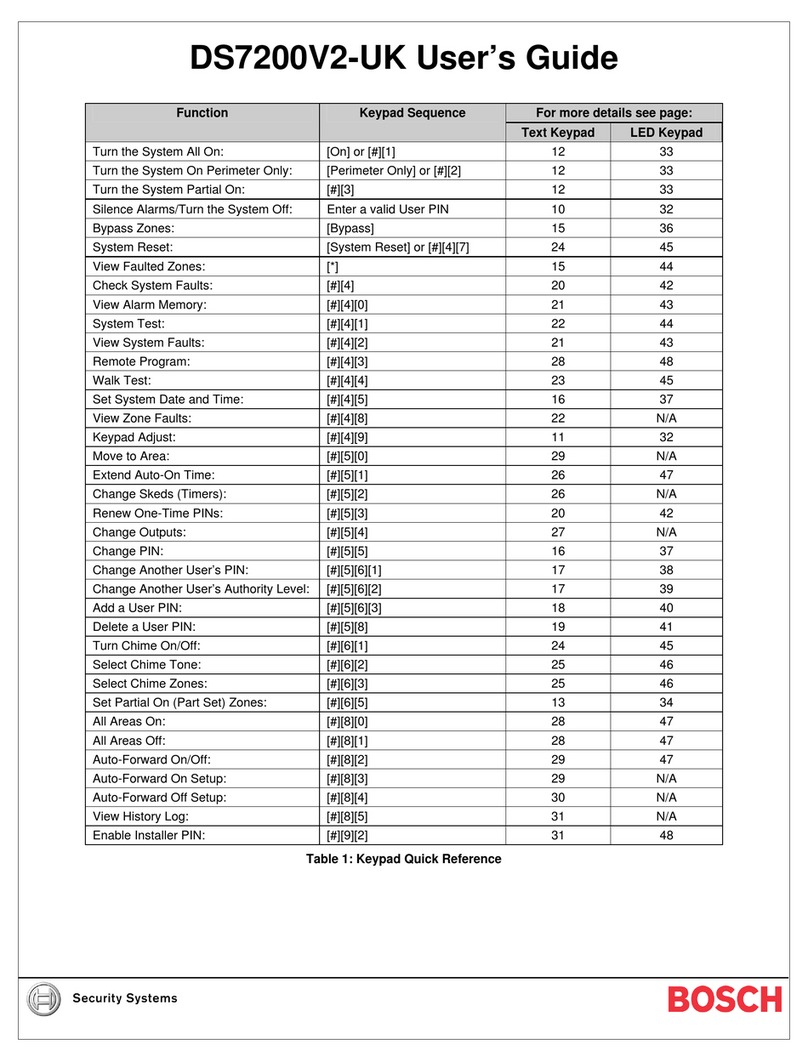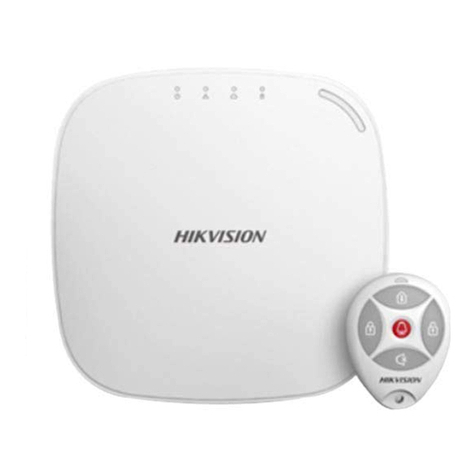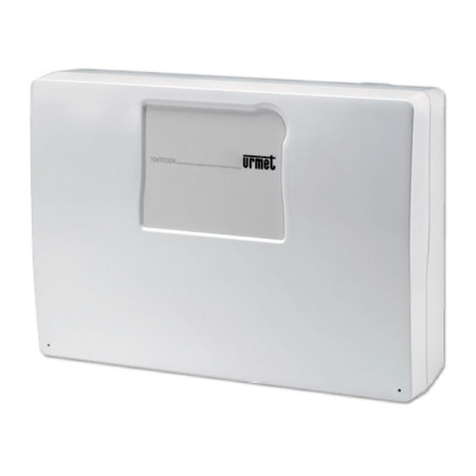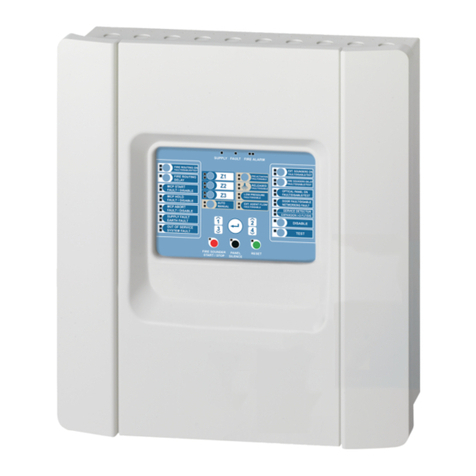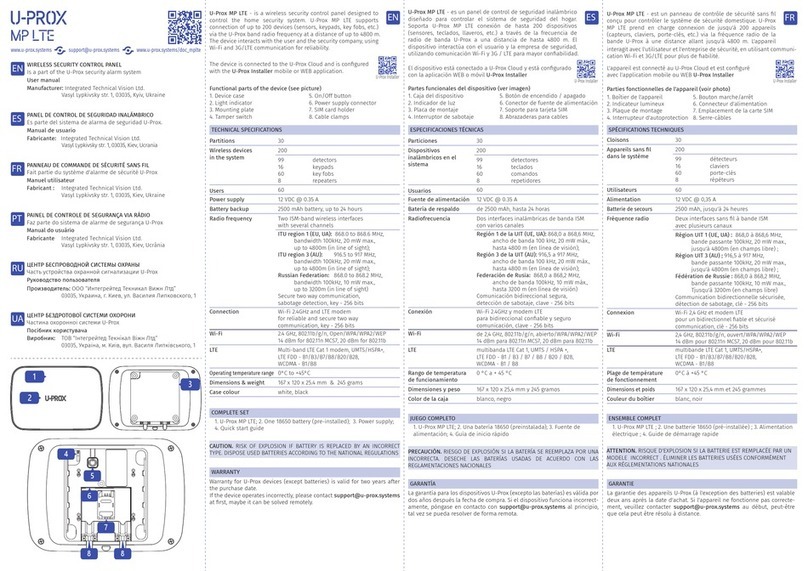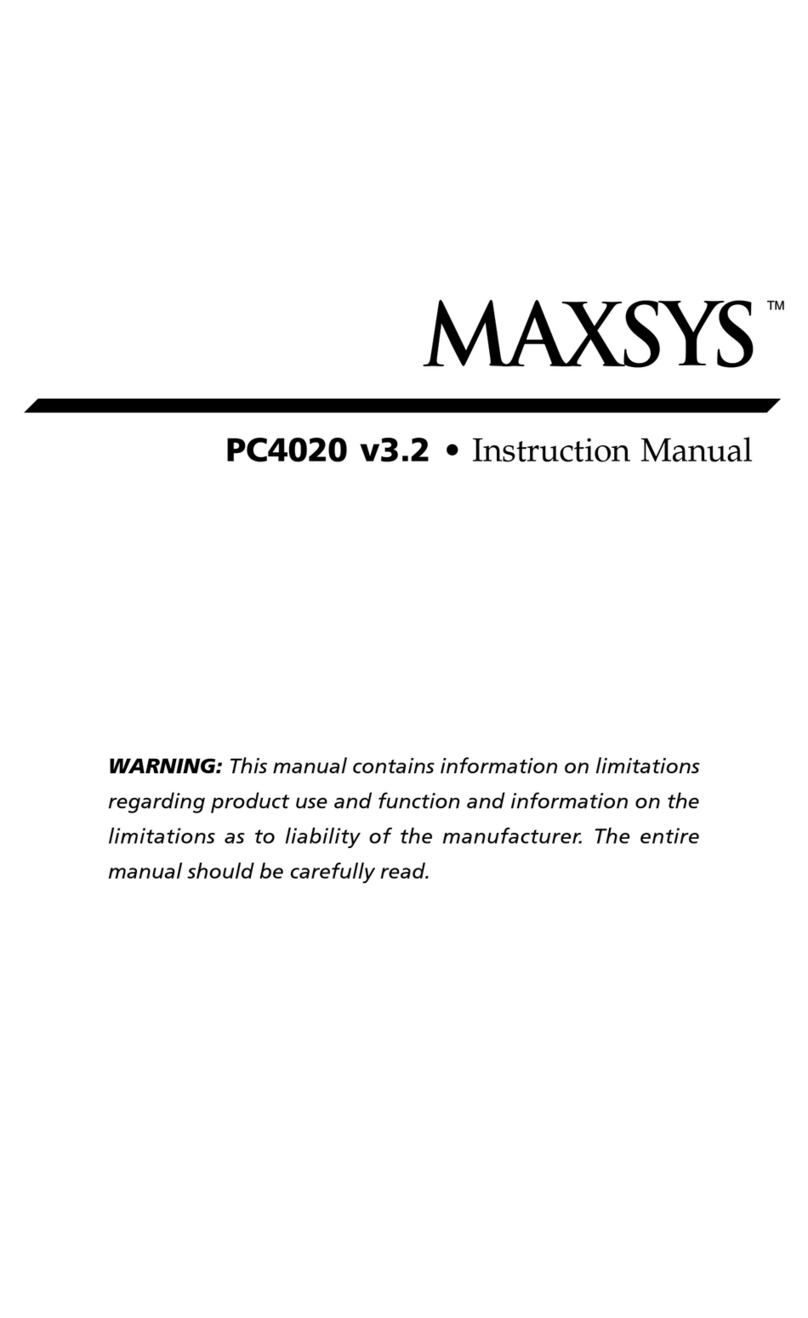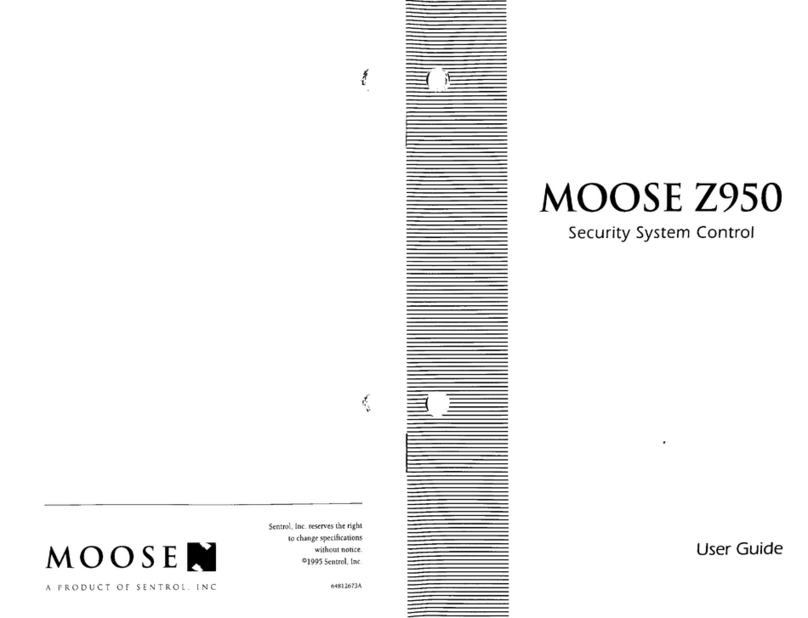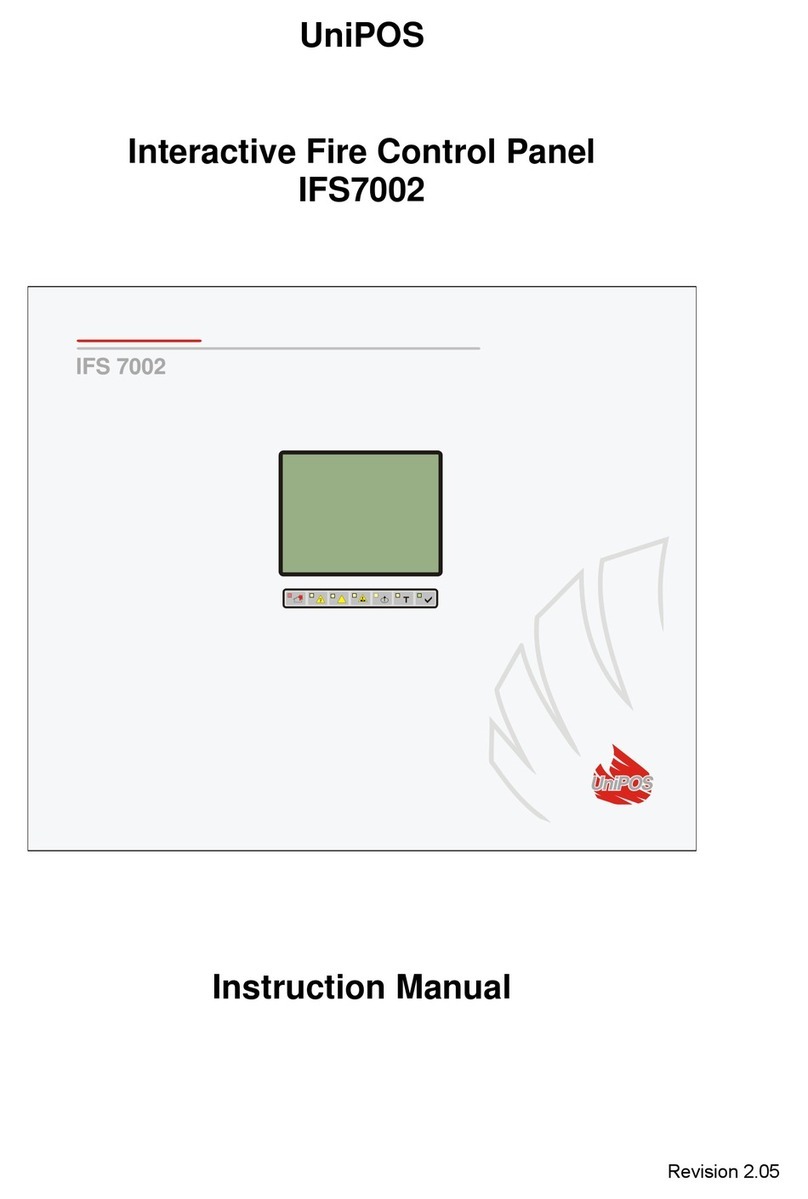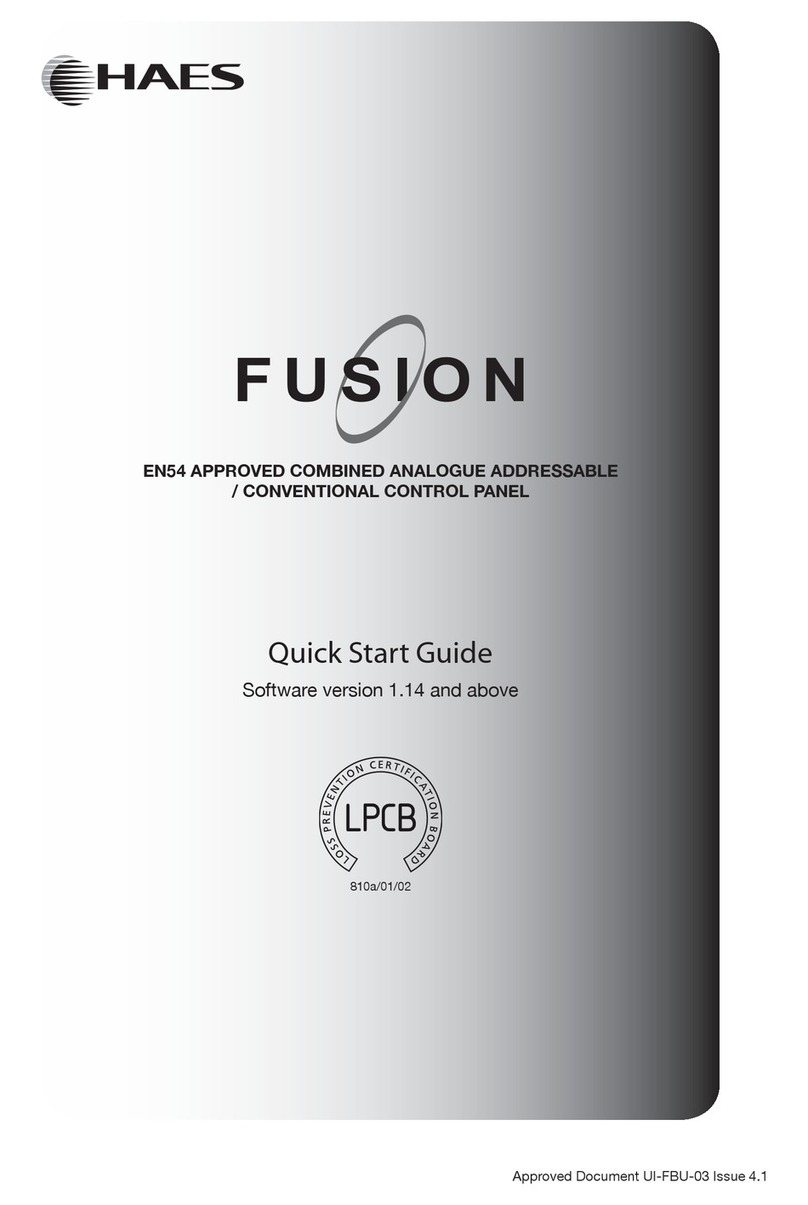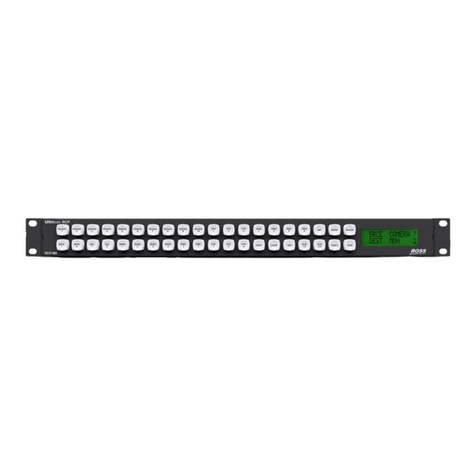Securiton SecuriFire 500 Guide

Securiton AG Alpenstrasse 20 3052 Zollikofen Switzerland T 811 065 en
SecuriFire 500
Mounting and Installation
Technical Description


Imprint
Mounting and Installation, Technical Description, T 811 065 en 3 / 41
Imprint
Notice
This document, T 811 065, is valid only for the product described in Section 1.
This documentation is subject to change or withdrawal without prior notice. The validity of the statements made
in this document applies until the statements are revised by a new edition of the document (T number with new
index). The user of this document is responsible for staying up to date with its current status through the edi-
tor/publisher. We accept no responsibility for claims against any incorrect statements in this document which
were unknown to the publisher at the time of publication. Handwritten changes and additions are not valid. This
document is protected by copyright.
Foreign language documentation as listed in this document is always released or changed at the same time as
the German edition. If there are inconsistencies between the foreign language documentation and the German
documentation, the German documentation is binding.
Some words in this document are highlighted in blue. These are terms and designations which are the same in
all languages and are not translated.
Users are encouraged to contact the editor/publisher if there are statements which are unintelligible, misleading,
incorrect, or if there are errors.
© Securiton AG, Alpenstrasse 20, 3052 Zollikofen, Switzerland
This document, T 811 065
1
, is available in the following languages: German T 811 065 de
English T 811 065 en
French T 811 065 fr
Italian T 811 065 it
Current edition: First edition 24.10.2012 Rd
1
Reference document: SecuriFire 500 Manual, V 1.0

Safety information
4 / 41 Mounting and Installation, Technical Description, T 811 065 en
Safety information
Provided the product is deployed by trained and qualified persons in accordance with technical document T 811 065 and the
danger, safety and general information notices in this technical documentation are observed, there is no danger to persons or
property under normal conditions and when used properly.
National and state-specific laws, regulations and directives must be observed and adhered to in all cases.
Below are the designations, descriptions and symbols of danger, safety and general information notices as found in this
document.
Danger
Danger to persons and/or property may result from the product and any system parts if danger notices are not
heeded. If the product and/or its parts become damaged and cause malfunctions there is also the risk of injury to
persons and damage to property.
•Description of which dangers may occur;
•Measures and preventative actions;
•How dangers can be averted;
•Other safety-relevant information.
Warning
The product may be damaged if the safety information is not heeded.
•Description of which damage can occur;
•Measures and preventative actions;
•How dangers can be averted;
•Other safety-relevant information.
Notice
The product may malfunction if this notice is not observed.
•Description of which malfunctions can be expected
•Measures and preventative actions;
•Other safety-relevant information.
Recycling / Environmental protection
Neither the product nor its components present a hazard to the environment provided they are handled properly.
•Description of which parts have environmental protection issues
•Description of how devices and their parts have to be disposed of in an environmentally-friendly way;
•Description of the recycling possibilities.
Batteries
It is not permitted to dispose of batteries in the domestic rubbish. As the end user you are legally obliged to re-
turn used batteries. Used batteries can be returned to the seller or brought to a designated recycling centre (e.g.
a communal collection point or retailer) at no cost. You may also send them back to the seller by post. The seller
will refund the postage when you return your old batteries.

Document history
Mounting and Installation, Technical Description, T 811 065 en 5 / 41
Document history
First edition Date 24.10.2012


Contents
Mounting and Installation, Technical Description, T 811 065 en 7 / 41
Contents
_________________________________________________________________________________________
1
System overview 9
1.1
Technical data 11
1.2
System limits 11
1.2.1
SecuriFire 500 11
1.2.2
SecuriLine eXtended 11
_________________________________________________________________________________________
2
Housing design & mounting 12
2.1
Integrated B7-MIC11 indication and control map 13
2.2
Drilling plan 13
_________________________________________________________________________________________
3
Interfaces & connections 14
3.1
B7-CPB11 main control unit 14
3.1.1
Interfaces 14
3.1.2
Technical data 14
3.1.3
Compatibility notice 14
3.2
Power supply 15
3.2.1
Mains connection 15
3.2.2
Technical data 15
3.2.3
Emergency power supply (batteries) connection X14 16
3.2.4
Technical data 16
3.2.5
Connection of external consumers 16
3.2.6
Technical data 16
3.2.7
Connection of relay outputs to B7-CPB11 17
3.2.8
Technical data 17
3.2.9
Connection examples 18
3.3
Connection of monitored inputs and outputs 19
3.3.1
Technical data 19
3.3.2
Connection of monitored outputs to B7-CPB11 20
3.3.3
Connection of inputs to B7-CPB11 20
3.4
EPI bus for external indication and control maps (X6) 21
3.4.1
EPI bus (X6) connection 21
3.4.2
Technical data 21
3.5
SecuriLine eXtended 22
3.5.1
SecuriLine eXtended (x12) connection 22
3.5.2
Technical data 22
3.5.3
Compatibility information 22
3.6
Connection of SecuriLine eXtended modules 23
3.6.1
Stub line connection 24
3.6.2
Connecting detector base USB 501 24
3.6.3
Connection of MCP 535x and MCP 545x manual call points 25
3.6.4
Connection of BX-AIM advanced input module 25
3.6.5
BX-IM4 input module connection 26
3.6.6
BX-I2 input module connection 27
3.6.7
BX-IOM input/output module connection 28
3.6.8
BX-OI3 output/input module connection 29
3.6.9
BX-O2I4 output/input module connection 30
3.6.10
BX-O1 output module connection 30
3.6.11
BX-REL4 relay module connection 31
3.6.12
BX-RGW radio module connection 31
3.6.13
Connection of the BX-SOL loop siren 32
3.6.14
Loop flashlight BX-FOL connection 32
3.6.15
Connection of end switch module eXtended Line BX-ESL 33
3.7
Recommended cable type for addressable loop 33
_________________________________________________________________________________________
4
Programming and software 34
_________________________________________________________________________________________
5
Planning 35
5.1
Loop length 35
5.2
Current consumption and bridging time 35
5.3
Typical power consumption values for B7-CPB11 35
5.4
Power requirement calculation 35
5.5
Battery current measurement with a connected battery pair 36

Contents
8 / 41 Mounting and Installation, Technical Description, T 811 065 en
_________________________________________________________________________________________
6
Commissioning 37
6.1
Program 37
6.2
SecuriLine eXtended addressable loop 37
6.3
Object-specific texts 37
6.4
Possible displays & fault patterns 38
6.5
Simple troubleshooting 38
6.5.1
General 38
6.5.2
Contaminated detector 38
6.5.3
Possible causes of faults 38
_________________________________________________________________________________________
7
Article numbers / spare parts 39
7.1
SecuriFire 500 fire alarm control panels 39
7.2
SecuriFire addressable loop modules 39
7.3
SecuriFire EPI devices 40
_________________________________________________________________________________________
8
List of figures 41

System overview
Mounting and Installation, Technical Description, T 811 065 en 9 / 41
1 System overview
The SecuriFire 500 1-loop small control panel consists of a plastic housing and a B7-MIC11 control panel integrated in the
door. Labelling of the control panel is language neutral.
The built-in main control unit with integrated power supply unit includes all interfaces for connecting peripherals. The lower
area of the housing provides enough space for installing two 7.2 Ah batteries.
Fire brigade maps and remote external display panels are connected by means of the EPI bus. A 100 Mbit TX LAN interface
can be used for remote access to the control panel.
The control panel has VdS approval compliant with EN 54-2 and EN 54-4 and is suitable for connecting a 110 V voltage sup-
ply (e.g. for markets in South America).
Fig. 1 System overview of SecuriFire 500
Important features
•A maximum of 250 participants on the loop and loop length up to 3,500 m.
•Up to 3 indication and control maps (e.g. fire brigade maps) can be connected via EPI bus
•3 relay outputs
•Alphanumeric display (320 x 240 pixels) in plain text, in German or in the language of the country of use, up to four lan-
guages can be toggled during operation. Thanks to the pictograms, the control panel user interface is not language spe-
cific.
•Connection for access using TCP/IP with mobile terminals via Internet/intranet
•Connection to management system
•Customer-specific software for freely programmable inputs and outputs
•Suitable for connection to the public alarm system of the fire brigade.
•Continual, automatic check routines for all system components and programs.
•Microprocessor-controlled and monitored system technology.
•Free assignment of detection zones and individual detectors
•Adjustable survey and delay times
•Alphanumeric, individual alarm display and group display of all alarm states
•Individually programmable auxiliary texts for each element
•Complies with the following relevant standards and directives: European standards EN 54, DIN and VDE.
•VdS devices and system approval (G212112, Sxxxxxx), CPD certificate 0786-CPD-21185

System overview
10 / 41 Mounting and Installation, Technical Description, T 811 065 en
Overvoltage protection
The SecuriFire 500 is equipped with a comprehensive and integrated overvoltage protection design which protects all periph-
eral inputs, including the mains power supply in compliance with EN 50130-4 (EMC) and EN 50082-2 (resistance to interfer-
ence for industry). The EMC protection design protects the electronics by means of a zone concept, Transzorp diodes, filters
and broadband decoupling of the power supply. Thus, when the system is used in buildings with installed basic and medium
protection (lightning protection, mains overvoltage arresters), no further measures (e.g. overvoltage arresters) are required.
Earthing concept
The earthing concept used in the SecuriFire 500 with central protection earthing to protect persons and electronics requires
that all electrically charged components connected to the GND line of the SecuriFire 500 control panel may be installed ex-
clusively in areas and buildings which have regulation-complaint potential equalization with this sub-control unit.
Warning
Non-observance can cause malfunctions and/or damage the control panel and may endanger people!
Software
The SecuriFire 500 control panel is equipped with a multitasking-capable, real-time operating system. A basic function pro-
gram is loaded into the system and is adjusted to the object to be protected by means of customer-specific programming
while taking into consideration relevant applicable standards.
Notice
This document applies to SRP 1.2 (SecuriFire Release Package) and later.
It is always recommended to use the most recent SecuriFire SW version.

System overview
Mounting and Installation, Technical Description, T 811 065 en 11 / 41
1.1 Technical data
Mains voltage / mains frequency: 230 V or 110 VAC (+/-15%), 47 Hz - 63 Hz
Operating voltage: Typically 27.3 V, depending on ambient temperature and loading state
Usable batteries: 2 pcs. 7.2 Ah in series
Emergency current supply with batteries: According to power calculation
Alarm current: Max. 1.7 A
Ambient temperature: -5°C to +50°C, measured at natural convection
Colour: Charcoal grey RAL 7016
Relative air humidity: 5% to 95%, without condensation
Air pressure: <= 80 kPa, up to 2,000 m above sea level
Protection class: IP 30
Electrical protection: EMC using a zone concept, Transzorp diodes, filters and broadband de-
coupling of the power supply of the electronics protective earth to protect
persons and electronics.
Dimensions: 300 x 360 x 100 mm
Weight without batteries: 2.5 kg
Weight with batteries: 7.8 kg
1.2 System limits
1.2.1 SecuriFire 500
Main indication and control map (MIC) 1 internal, max. 4 VirtualMIC
Interfaces to management systems 4 incl. message server and SMS server
External indication and control maps including
fire brigade panels
max. 3 EPI devices with max. 1 metre line length
Detection zones, inputs, outputs max. 756, dynamically divided
External (e.g. sprinkler systems) max. 256
Delay layers max. 16
Customer-specific texts 6,500 if average is 25 characters per element
1.2.2 SecuriLine eXtended
SecuriLine eXtended
High Power Mode
SecuriLine eXtended
Long Range Mode
SecuriLine
DAI mode
SecuriLine eXtended per loop max. 250 max. 250 max. 128
SecuriLine eXtended per stub max. 64 max. 64 max. 64
BX-SOL, BX-SBL per loop max. 62 LOW,
max. 31 HIGH
max. 32 LOW,
max. 31 HIGH
max. 31 LOW,
max. 15 HIGH
BX-FOL per loop max. 23 max. 23 max. 23
Loop length max. 1500 m max. 3500 m max. 2000 m
max. line resistance according to loop length calculation
Detailed specifications are included in the release notes of SecuriFire Studio.
Notice
The actual loop length depends on the number and type (power consumption, inner resistance) of participants,
on additional power load (number of switched on alarm LEDs, telegram current), and on the cable cross-section.
This means that for the optimal configuration the number of participants and the coverage range of the loop must
be matched to each other.
A tool is available for calculating the maximum possible loop length and the maximum number of participants.

Housing design & mounting
12 / 41 Mounting and Installation, Technical Description, T 811 065 en
2 Housing design & mounting
The B7-CPB11 main control unit of the SecuriFire 500 contains interfaces for connecting an addressable loop, 2 monitored
inputs and outputs for each alarm transmission and transmission unit compliant with EN 54, and 3 relay outputs. The power
supply unit is integrated on the main control unit.
Every SecuriFire 500 control panel consists of:
•Housing for wall mounting with door (with control panel, without
printer)
•B7-CPB11 main control unit with
1x SecuriLine eXtended loop (max. 250 participants, max. 3,500 m)
2 primary outputs
2 primary inputs
3 relay outputs
EPI bus connection (max. 3 devices, max. 1 m)
•24 V / 2.5 A power supply unit (integrated)
•2 pcs. 12 V / 7.2 Ah emergency power batter-
ies in series
•Mains terminals and battery cable
•Integrated indication and control map (B7-
MIC11)
2
3
4
5
6
1a
1b
11
Fig. 2 Inside view of housing
1a Plastic housing / door
1b Plastic housing / rear wall
2Mounting main indication and control map
3Main indication control map connection
4Main control unit
5Integrated power supply unit
6Batteries
7Holes for wall mounting
8Mains connection entry
9Loop line and input/output entry
10 EPI bus and Ethernet entry
11 The cable can also be conveyed through the bottom side
of the housings on surface mounting. To do so, it is neces-
sary to drill out the prepared location with a so-called ta-
pered bit. The cable can then be conveyed through the
centre part between the batteries to the connection on the
main control unit.
7
7
7
7
8
9
10
Fig. 3 Rear view of housing

Housing design & mounting
Mounting and Installation, Technical Description, T 811 065 en 13 / 41
2.1 Integrated B7-MIC11 indication and control map
Fig. 4 Front view of housing
The B7-MIC11 indication and control map is language-
neutral and a permanently integrated component of the
SecuriFire 500.
The connection to the main control unit is by means of
a ribbon cable.
SecuriFire 500 has the same operating concept as the
corresponding devices of the SecuriFire system family.
The SecuriFire operating instructions are applicable.
2.2 Drilling plan
All dimensions in mm.
Fig. 5 SecuriFire 500 drilling plan
•Mount rear wall according to drill plan with 4 pcs.
5 x 40 round head screws and 4 pcs. S 8 dowels.
When mounting on plaster board, appropriate
dowels and reinforcement may be necessary.
Weight incl. batteries: 7.8 kg!
•Place batteries and connect
•Wire mains connection
Notice
Rating plates
Each SecuriFire 500 map case is delivered with two rating plates. One of them is already attached at the factory
on the right inside in the map case over the batteries. The second rating plate is packaged with the control unit
and has to be attached in access level 1 (outside on the map case) before commissioning where it can be easily
seen.

Interfaces & connections
14 / 41 Mounting and Installation, Technical Description, T 811 065 en
3 Interfaces & connections
3.1 B7-CPB11 main control unit
The B7-CPB11 (Controller and Power Supply Board) main control unit is a component of every SecuriFire 500 control panel
and includes all interfaces for connecting peripherals, monitored inputs and outputs, service PC and the integrated power
supply unit. The mounting main indication and control map is connected to the main control unit using a ribbon cable.
Fig. 6 B7-CPB11 main control unit
System states are indicated by LEDs (V 50). All programming and configuration procedures are performed via the LAN inter-
face (X13) by means of the service PC and SecuriFire Studio.
3.1.1 Interfaces
X1 Mains connection 230 V / 110 V
X2 Control panel interface to the B7-MIC11
X5 Interface of the relay contacts
X6 Interface for EPI bus (extended bus)
X10 Interface for monitored inputs and outputs
X11 Output voltage for external consumers
X12 Interface for 1 addressable loop or 2 stub lines
(SecuriLine eXtended)
X13 Ethernet 100BASE-TX service interface for loading
program and planning data and for system diagnos-
tics
X14 Battery connection
T2 Button for control panel reset
V50 State LEDs for master processor
LED dark fault
LED lit startup
LED flashing normal operation
T1 On/Off switch (power)
3.1.2 Technical data
Quiescent power consumption: 62.9 mA (battery current)
Supply voltage: Battery voltage VL; VP +22 V .. 30 V
Logic voltage VCC +3.3V ± 5%
Rel. air humidity: 5% to 95%, without condensation
Ambient temperature: -5°to +50°C
3.1.3 Compatibility notice
The B7-CPB11 main control unit as of version 20-1151100-01-01 is supported as of SecuriFire Studio Rel. 1.2.0.

Interfaces & connections
Mounting and Installation, Technical Description, T 811 065 en 15 / 41
3.2 Power supply
For the power supply from the mains network, a circuit of 230V / 50 Hz (110 V / 60 Hz) must be planned; it must have auto-
matic cut-outs (min. 10 A surge resistant) and have its own FI safety switch (U characteristic).
Notice
Installation of the SecuriFire 500 system components and the mains connection may be performed only by tech-
nicians trained specifically for this purpose; installation must always adhere to the applicable rules and regula-
tions of the country concerned (e.g. DIN, VDE).
The fire alarm system must be operated via its own line network. All work is to be carried out in a de-
energized
state (mains and battery) and without external voltage.
When manipulating the individual units, it is imperative that you observe the regulations regarding precautions
against static charges (ESD protective measures).
3.2.1 Mains connection
From building distributor
Fuse at least 10A
Own Fl switch
Bayonet fuses
L1
N
PE
BATTERY
12V - 7Ah
8A
BATTERY
12V - 7Ah
Bat
- + N L PE
B7-CPB11
8A
Fig. 7 Mains connection
X1 connector plug
Designation Pin
L 1
N 2
PE 3
The mains cable is introduced into the control panel through the opening in the rear wall and is connected to the B7-CPB11
main control unit on the terminal for this purpose. The PE protective earth is connected to the marked earth screw; the battery
cable set is packaged with each control panel and is connected to the power supply unit and batteries.
3.2.2 Technical data
Connection: ~230 V / 110 V (± 15%)
Mechanical design: 3-pin screw terminal, RM 3.81
cable cross-section of 0.14 to 2.5 mm
2

Interfaces & connections
16 / 41 Mounting and Installation, Technical Description, T 811 065 en
3.2.3 Emergency power supply (batteries) connection X14
Designation Pin
Bat+ 1
Bat- 2
3.2.4 Technical data
Connection: Battery 7 Ah
Mechanical design: 2-pin screw terminal, RM 3.81
cable cross-section of 0.14 to 2.5 mm
2
To ensure the fire alarm system continues to function even when there is a brief interruption of the power supply, two batteries
connected in series are built into each SecuriFire 500. If there is a mains failure, they provide the power for the control unit.
The batteries are mounted below in SecuriFire 500 map case.
Notice
Only the following VdS tested and Securiton approved battery types can be used; if others are used, trouble-free
functioning of the system cannot be assured:
Battery type VdS approval
CTM CT7-12 G103049
3.2.5 Connection of external consumers
X11 connector plug
Designation Pin
VEXT + 1
VEXT - 2
For connecting external consumers such as key safe etc. The output voltage is 24 V; maximum output current is 0.5 A. The
output is short-circuit-proof with a self-healing fuse.
3.2.6 Technical data
Connection: Output voltage +20 V to +30 V, max. 0.5 A
Mechanical design: 2-pin screw terminal, RM 3.81
cable cross-section of 0.14 to 2.5 mm
2

Interfaces & connections
Mounting and Installation, Technical Description, T 811 065 en 17 / 41
3.2.7 Connection of relay outputs to B7-CPB11
The X5 connector plug on the B7-CPB11 main control unit has 3 freely programmable bistable 240 V/3 A relay contacts for
actuating sirens, permanent magnets, relays, etc. With planning software you can define whether the contact is a working
contact or normally closed contact. By programming an “Active in fail-safe position”, the state of each individual relay can be
defined for power supply failure or shut down of the control panel.
X5 connector plug
Pin Designation Relays
1 R1 1
2 R1
3 R2 2
4 R2
5 R3 3
6 R3
3.2.8 Technical data
Relay outputs: 3
Relay design: Bistable
Contact resistance: 30 mΩmax.
Max. switching voltage: 240 VAC / 125 VDC
Max. switching current: 3 A
Max. switching capacity: 300 W / 2500 VA
Monitoring voltage: Typically 24 V
Monitoring current: Typically 3.1 mA
Short-circuit current: Typically 3.63 mA
Termination resistance: 220 Ω

Interfaces & connections
18 / 41 Mounting and Installation, Technical Description, T 811 065 en
3.2.9 Connection examples
1 6
X5
B7-CPB11
Consumer
max. 230V~ / 3A / 300W
Fig. 8 B7-CPB11, relay output (connection of 230 V consumers)
1 6
X5
B7-CPB11
X11
1
2
Siren
Working
contact
Fig. 9 B7-CPB11, relay output (siren connection)
When connecting inductive loads, it is recommended
to use a freewheel diode (e.g. 1N40007)
1 6
X5
B7-CPB11
X11
1
2
Permanent
magnet
Normally
closed
contact
HM
Fig. 10 B7-CPB11, relay output (permanent magnet connection)

Interfaces & connections
Mounting and Installation, Technical Description, T 811 065 en 19 / 41
3.3 Connection of monitored inputs and outputs
The X10 connector plug on the B7-CPB11 main control unit is for connecting the transmission unit (main detector) and alarm
unit (sirens) for loads between 16 and 1 k. The interface includes two 1.5 A control outputs monitored for short-circuit and
wire breakage and 2 monitored inputs. The OM1 output has a feedback input for external trigger confirmation.
X10 connector plug
Pin Designation Function
1 OM1+ +24V
2 OM1- GND
3 OM1CF+/- Feedback input
4 OM2+ +24V
5 OM2- GND
6 IM1+ Input 1
7 IM1- GND
8 IM2+- Input 2
9 IM2- GND
3.3.1 Technical data
Monitored outputs OM1 and OM2
Output voltage: 22 V min., 24 V typical, 28 V max.
Output current: max. 0.5 A (TUS max. 0.1 A)
OM modes of operation: Monitored output with area 1 and 2 or TUS (TUS only for OM1),
Planning with software; see table for values
Feedback input: Feedback from MDLF
Input current 3.1 mA
Polarity Feedback contact can switch to plus and minus
Output
voltage
Mode of
operation Load range Output current Quiescent
current Short-circuit current Line resistance
22V to 28V
Range 1 160-1000 max. 0.5 A 1 mA Typically 1.75 A max. 50
Range 2 57-375 max. 0.5 A 3 mA Typically 1.75 A max. 20
TUS
(only OM1)
max. 0.1 A Typically 0.137 A max. 20
Range 1 160-1000 max. 0.5 A 1 mA Typically 1.75 A max. 50
Range 2 57-375 max. 0.5 A 3 mA Typically 1.75 A max. 20
Monitored inputs IM1 and IM2
Purpose: Polling galvanically isolated contacts or key safes and isolating facilities
Monitoring voltage: Typically 24 V
Monitoring current: Typically 3.1 mA
Short-circuit current: Typically 3.63 mA
Termination resistance: 220
Initiating resistance: 220
Line resistance: 50 max.

Interfaces & connections
20 / 41 Mounting and Installation, Technical Description, T 811 065 en
3.3.2 Connection of monitored outputs to B7-CPB11
Quiescent current monitored loads
1
B7-CPB11
X10
9
“Electronic loads”
1
B7-CPB11
X10
9
1k
+
_
Fig. 11 B7-CPB11, quiescent current monitored loads Fig. 12 B7-CPB11, electronic loads
Connection with feedback
+
_
Transmission
unit
1
B7-CPB11
X10
9
Notice
Because of the number of different transmis-
sion unit systems, their description is not in-
cluded in this document. See the manufac-
turer's documentation for more information.
Fig. 13 B7-CPB11, connection with feedback
3.3.3 Connection of inputs to B7-CPB11
Monitored inputs Unmonitored inputs
220 R
220 R
1
B7-CPB11
X10
9
1
B7-CPB11
X10
9
Fig. 14 B7-CPB11, connection of inputs
Other manuals for SecuriFire 500
1
Table of contents
Other Securiton Control Panel manuals

